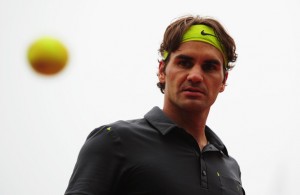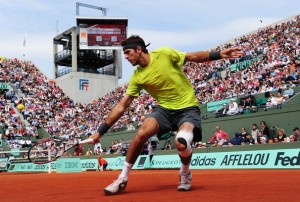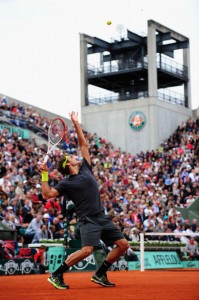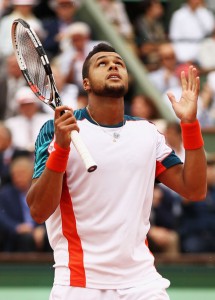French Open, Day Ten
Much like other radioactive substances, the tournament draw at the 2012 French Open cleaves to a more or less fixed rate of exponential decay, weather permitting. After a slow start, the event discards precisely half its mass as charged particles every two days, although some of the particles are less charged than others. Paul-Henri Mathieu was an exhausted particle. Mikhail Youzhny was both enraged and contrite. With four half-life cycles complete, the original 128 participants had been reduced to just eight. Nuclear chemists traditionally call this point the ‘quarterfinals’, and I can see no reason to avoid the term. Eight remaining participants means four remaining interactions between them – called ‘matches’ – since it is an innate property that these particles must be paired before decay occurs, whereupon one of them is given off as heat (often in the form of hot air).  With only four matches to get through in two days – neatly divided into two per day – this leaves considerable time in which these interactions can occur. The question therefore begs: why on earth would you schedule the day’s two quarterfinals to be played at the same time?
With only four matches to get through in two days – neatly divided into two per day – this leaves considerable time in which these interactions can occur. The question therefore begs: why on earth would you schedule the day’s two quarterfinals to be played at the same time?
At one point Roland Garros – via the miracle of Twitter – named the del Potro-Federer encounter its match of the day, but failed to explain why the match of the day was being played on Lenglen instead of Chatrier, and at the same time as a match between the world No.1 and the only Frenchman remaining in the draw. Now, I cannot cavil at the choice of courts. Novak Djokovic and Jo-Wilfried Tsonga certainly produced a spectacle worthy of the venue. Furthermore, the scheduling did throw up a few remarkable moments of simultaneity, the most exquisite coming when both Federer and Tsonga moved to match point at almost precisely the same moment. You don’t see or hear that too often, and the roars from Chartier resonated almost perfectly through the two streams I had running. The vocal crowd on Lenglen loved Federer, even after he’d earlier directed some tough love back at them, but the swell from the main court built into a vast breaker, that then crashed across the grounds and through my speakers.
But, souvenir-value aside, match points in matches as big as this deserve to be appreciated in isolation, and the excitement was more cancelled out than augmented by trying to follow both. Interviewed the next day, Federer revealed just how distracting it had been, and how he’d requested that they stop showing constant updates from the other match on the Lenglen scoreboard. It should be said that those following the earlier women’s quarterfinals faced an identical dilemma (both scheduled at the same time). In both cases the problem would have been ameliorated by putting the men’s match on first on one of the courts. Not both, though, that would be foolish, although I wouldn’t put it past the French Open to propose this as a solution. At least one can hope they’ve learned their lesson for tomorrow’s remaining quarterfinals. It therefore no surprise to note today’s schedule will be reprised perfectly.
(3) Federer d. (9) Del Potro, 3/6 6/7 6/2 6/0 6/3
For fans of Roger Federer, today’s quarterfinal with Juan Martin del Potro began in a depressingly familiar fashion, recalling the loss to Robin Soderling at the identical stage of the same tournament two years ago.  For fans of del Potro, the deflating familiarity came at the end. As their man, easily the better player through the early going, began to wilt noticeably in the third set, and then fade entirely as the fourth wound on, the comparison to the 2009 semifinal became unavoidable.
For fans of del Potro, the deflating familiarity came at the end. As their man, easily the better player through the early going, began to wilt noticeably in the third set, and then fade entirely as the fourth wound on, the comparison to the 2009 semifinal became unavoidable.
It was only gradually that I began to grasp Federer’s sophisticated rope-a-dope strategy in this match. In glacial conditions, he was never going to be able to hit through the court as effectively as del Potro, who, like Soderling, can effectively hit through a wall. As with the Rumble in the Jungle, when Ali allowed Foreman to wear himself out from punching him so much, Federer was icily content to let the Argentine – similarly proportioned to Foreman – grow exhausted from landing so many lusty body-blows.
I’m being facetious, of course. Icy is the last thing Federer was today, and through the initial stages, a strategy was the last thing he had. I can hardly recall him looking and sounding so fired up since . . . well, since the 2009 US Open final, when he was famously beaten half to death by del Potro’s haymakers. At one point he bellowed ‘Shut-up!’ at the someone in the crowd after they’d allowed their excitement to spill over during the rally. ‘I was (you know) sometimes upset,’ he remarked later.
It’s hard to know quite what to make of del Potro’s insistence later that his knee injury wasn’t crucial, although he maintained this line under persistent probing, and suggested that the frequent appearances from the trainer were just to loosen the taping. Pressed to deconstruct his drop-off, he evocatively credited Federer lifting – ‘I feel his ball more on the baseline’, which seems like a clear example of the hindrance rule – abetted by his own serve deserting him.  Certainly he served worse after the first two sets, but up until that point he had seemed quite dominant when the ball was in general play, and even from neutral positions he was generally the one forcing Federer to defend. It’s hard not to chalk his response up to gracious disingenuousness – he really wasn’t pushing off that side well – but he did remain indefatigable on the matter, even when obliged to explain himself at least four times.
Certainly he served worse after the first two sets, but up until that point he had seemed quite dominant when the ball was in general play, and even from neutral positions he was generally the one forcing Federer to defend. It’s hard not to chalk his response up to gracious disingenuousness – he really wasn’t pushing off that side well – but he did remain indefatigable on the matter, even when obliged to explain himself at least four times.
Still, it’s also undeniable that Federer’s game picked up. For perhaps the first time in this tournament, he began to look like himself in those last few sets. The first couple of sets saw him launch innumerable forehands long, and every backhand he sought to redirect up the line found a part of the net well below the top. From the third set those shots found the court, even through a persistent drizzle that rendered it ingravescent. He began to mix up his first serve – mostly mixing ‘in’ ones with the ‘out’ ones he’d been discontent to use earlier – and generally resembled the guy who’s beaten del Potro four times already this year. For two sets, this was a better del Potro than that, but then it was a much worse one. I don’t know what this means for Federer’s upcoming semifinal against Novak Djokovic.
(1) Djokovic d. (5) Tsonga, 6/1 5/7 5/7 7/6 6/1
A glance at the score line tells you a lot of what needs to be said about this match. The outer sets were dominated by Djokovic, but the middle three almost elevated it into a classic.  When Tsonga dished up the early break in the second, it really didn’t look like heading that way. Djokovic played an imperious first set, but then he’s developed a habit of doing that a bit this year. Think back to Miami, or even Rome. In contrast to last year, he has frequently thudded back to earth in the second. (Last year he returned to earth in October.) Tsonga broke back in typically enterprising fashion, and to his credit he never really stopped playing that way. Djokovic grew perceptibly anxious at the end of the next two sets, either spraying errors or tentatively allowing his opponent to impose himself. If there’s one thing Tsonga is willing to do – I’m sure there are lots of things – it’s impose himself.
When Tsonga dished up the early break in the second, it really didn’t look like heading that way. Djokovic played an imperious first set, but then he’s developed a habit of doing that a bit this year. Think back to Miami, or even Rome. In contrast to last year, he has frequently thudded back to earth in the second. (Last year he returned to earth in October.) Tsonga broke back in typically enterprising fashion, and to his credit he never really stopped playing that way. Djokovic grew perceptibly anxious at the end of the next two sets, either spraying errors or tentatively allowing his opponent to impose himself. If there’s one thing Tsonga is willing to do – I’m sure there are lots of things – it’s impose himself.
It’s hard to say enough about Djokovic’s composure when facing match points, although it’s a simple matter to say little of use. Tsonga had four match points in the fourth set – they marched in, two by two – and on each Djokovic discovered a typically mordant calm. Federer has twice proved in New York that two consecutive match points is not enough against Djokovic, a seemingly absurd concept that was nevertheless lent weight in Paris last year, when he needed three in a row to secure the win. There are arguably better players at saving match point, but Djokovic is the finest I’ve ever seen at surviving a pair of them. Admittedly, this is a highly specialised skill. It is quite useless to, say, trauma surgeons. But for the world’s highest ranked male tennis player, it certainly has its value, which we can determine by adding up all the prize money and prestige he would have foregone without it.  Djokovic himself could offer little explanation afterwards, and it’s not his job to. For myself, I maintain what seemed apparent at the US Open last year. His calm seems to stem from a deep gallows detachment. People who are very good at confrontation will perhaps recognise it, the way, at the uttermost end-point, all the concern and anxiety seems to evaporate, leaving a near-giddy sense of anticipation and delight.
Djokovic himself could offer little explanation afterwards, and it’s not his job to. For myself, I maintain what seemed apparent at the US Open last year. His calm seems to stem from a deep gallows detachment. People who are very good at confrontation will perhaps recognise it, the way, at the uttermost end-point, all the concern and anxiety seems to evaporate, leaving a near-giddy sense of anticipation and delight.
Giddy delight almost perfectly describes how Tsonga didn’t feel afterwards, although even he could barely parse what he was feeling: ‘You want to break your racquet. You want to shout. You want to cry. You want to laugh and say, ‘Oh come on, that’s a joke. How could I lose this match?’ You want to wake up.’ He knew that, as calm as his opponent was, he’d had a shot on those match points, particular that passing shot. He declared it to be the hardest loss of his career. I suspect, deep down, he really did believe a Frenchman could win the French Open.
For Djokovic, I don’t know what this means for his upcoming semifinal against Federer, except that the Swiss will need at least three match points to win, since anything less plays right into the Serbian’s hands. Hopefully the tournament will schedule them both to play at the same time.

16 Responses to Les Particules élémentaires